Improving Store Stock Logistics: A Business Capstone Project for Coles
VerifiedAdded on 2022/08/12
|10
|1968
|22
Project
AI Summary
This business capstone project analyzes the logistics strategies employed by Coles Supermarket to manage its store stock and optimize its supply chain. The project explores various aspects of logistics, including customer service, planning and forecasting, inventory management, order processing, communication, material handling, packaging, and transportation. It investigates how Coles utilizes automated processes to address out-of-stock problems and maintain a competitive advantage in the Australian market. The methodology focuses on quantitative forecasting techniques to monitor stock quantities and analyze consumer demand and behavior. The project aims to develop improved logistics practices to ensure effective store stock management, reduce out-of-stock issues, and enhance overall efficiency. The project's scope includes the impact of stock monitoring on supermarket performance, encompassing processes such as order management, inventory control, warehousing, and material handling. The conclusion emphasizes the importance of proper logistics planning for Coles to maintain a competitive edge and make strategic plans for timely stock replacement based on sales forecasting.
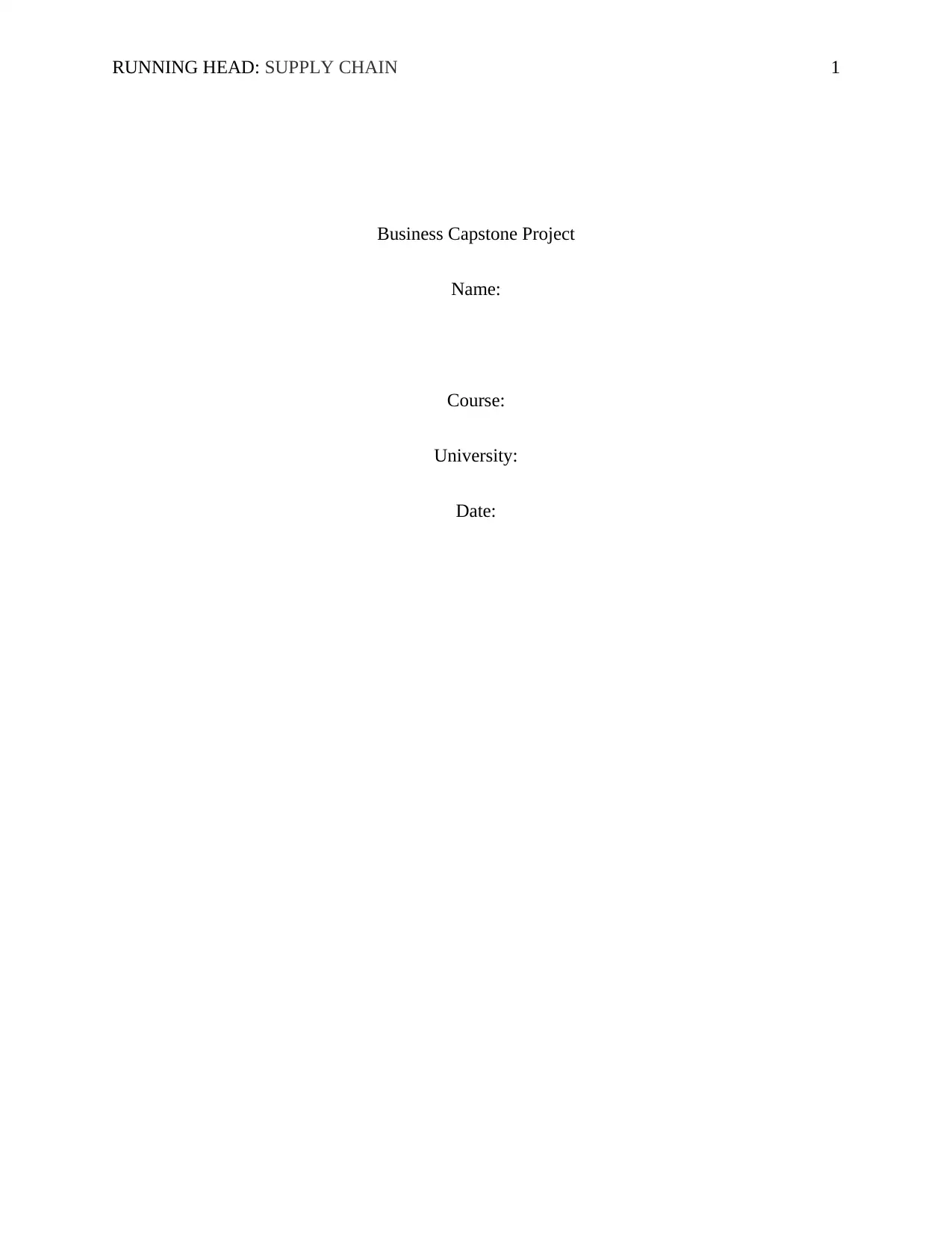
RUNNING HEAD: SUPPLY CHAIN 1
Business Capstone Project
Name:
Course:
University:
Date:
Business Capstone Project
Name:
Course:
University:
Date:
Paraphrase This Document
Need a fresh take? Get an instant paraphrase of this document with our AI Paraphraser
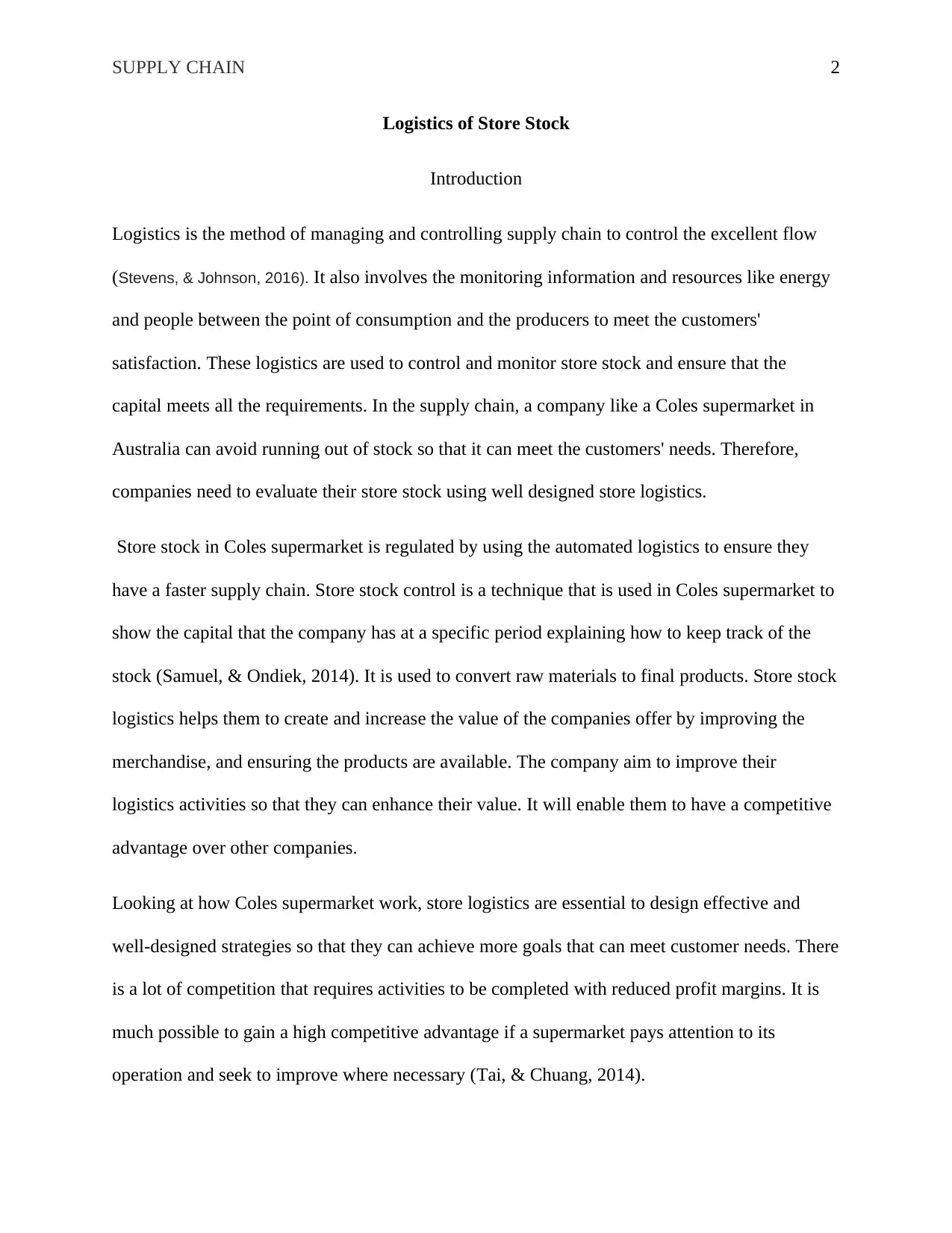
SUPPLY CHAIN 2
Logistics of Store Stock
Introduction
Logistics is the method of managing and controlling supply chain to control the excellent flow
(Stevens, & Johnson, 2016). It also involves the monitoring information and resources like energy
and people between the point of consumption and the producers to meet the customers'
satisfaction. These logistics are used to control and monitor store stock and ensure that the
capital meets all the requirements. In the supply chain, a company like a Coles supermarket in
Australia can avoid running out of stock so that it can meet the customers' needs. Therefore,
companies need to evaluate their store stock using well designed store logistics.
Store stock in Coles supermarket is regulated by using the automated logistics to ensure they
have a faster supply chain. Store stock control is a technique that is used in Coles supermarket to
show the capital that the company has at a specific period explaining how to keep track of the
stock (Samuel, & Ondiek, 2014). It is used to convert raw materials to final products. Store stock
logistics helps them to create and increase the value of the companies offer by improving the
merchandise, and ensuring the products are available. The company aim to improve their
logistics activities so that they can enhance their value. It will enable them to have a competitive
advantage over other companies.
Looking at how Coles supermarket work, store logistics are essential to design effective and
well-designed strategies so that they can achieve more goals that can meet customer needs. There
is a lot of competition that requires activities to be completed with reduced profit margins. It is
much possible to gain a high competitive advantage if a supermarket pays attention to its
operation and seek to improve where necessary (Tai, & Chuang, 2014).
Logistics of Store Stock
Introduction
Logistics is the method of managing and controlling supply chain to control the excellent flow
(Stevens, & Johnson, 2016). It also involves the monitoring information and resources like energy
and people between the point of consumption and the producers to meet the customers'
satisfaction. These logistics are used to control and monitor store stock and ensure that the
capital meets all the requirements. In the supply chain, a company like a Coles supermarket in
Australia can avoid running out of stock so that it can meet the customers' needs. Therefore,
companies need to evaluate their store stock using well designed store logistics.
Store stock in Coles supermarket is regulated by using the automated logistics to ensure they
have a faster supply chain. Store stock control is a technique that is used in Coles supermarket to
show the capital that the company has at a specific period explaining how to keep track of the
stock (Samuel, & Ondiek, 2014). It is used to convert raw materials to final products. Store stock
logistics helps them to create and increase the value of the companies offer by improving the
merchandise, and ensuring the products are available. The company aim to improve their
logistics activities so that they can enhance their value. It will enable them to have a competitive
advantage over other companies.
Looking at how Coles supermarket work, store logistics are essential to design effective and
well-designed strategies so that they can achieve more goals that can meet customer needs. There
is a lot of competition that requires activities to be completed with reduced profit margins. It is
much possible to gain a high competitive advantage if a supermarket pays attention to its
operation and seek to improve where necessary (Tai, & Chuang, 2014).
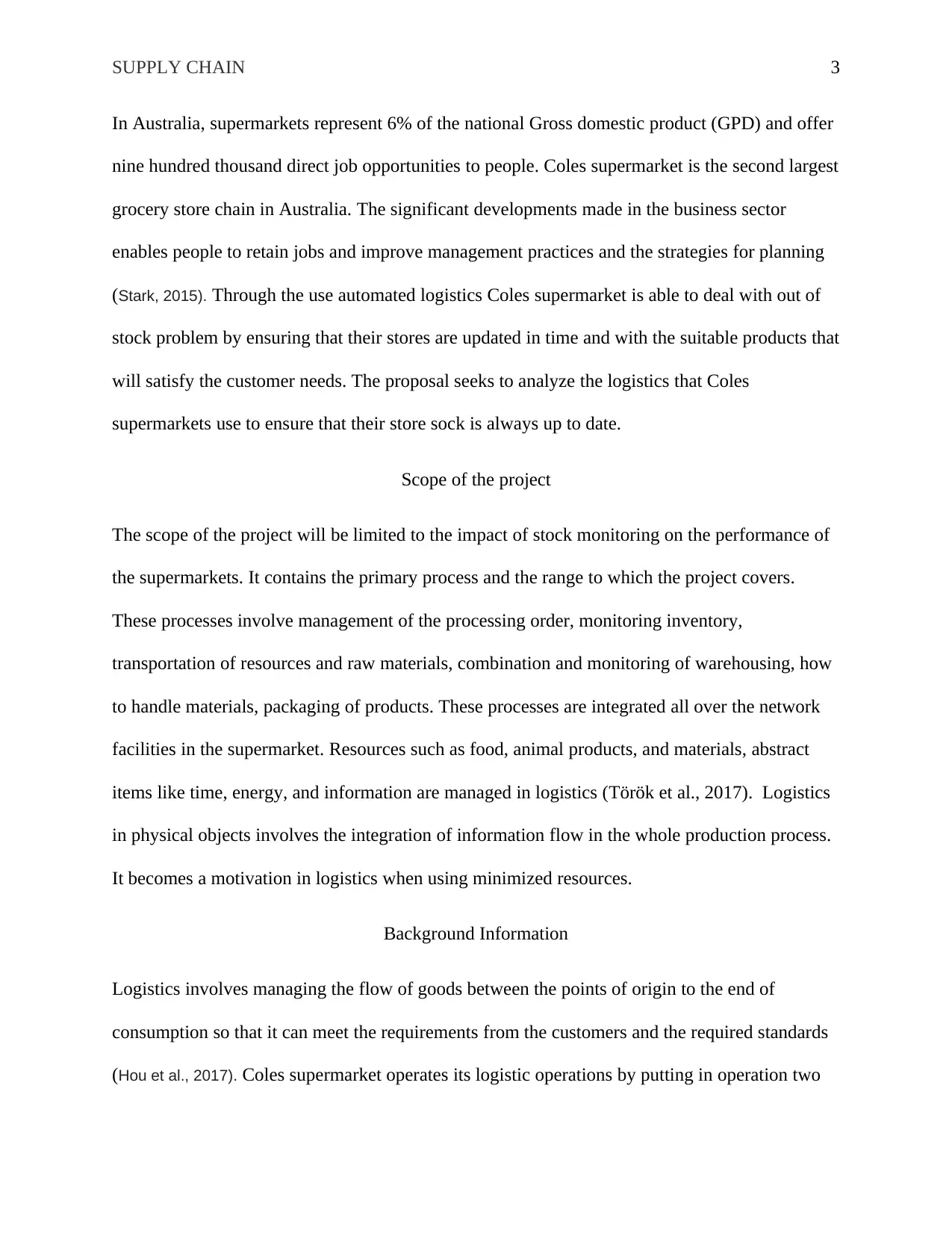
SUPPLY CHAIN 3
In Australia, supermarkets represent 6% of the national Gross domestic product (GPD) and offer
nine hundred thousand direct job opportunities to people. Coles supermarket is the second largest
grocery store chain in Australia. The significant developments made in the business sector
enables people to retain jobs and improve management practices and the strategies for planning
(Stark, 2015). Through the use automated logistics Coles supermarket is able to deal with out of
stock problem by ensuring that their stores are updated in time and with the suitable products that
will satisfy the customer needs. The proposal seeks to analyze the logistics that Coles
supermarkets use to ensure that their store sock is always up to date.
Scope of the project
The scope of the project will be limited to the impact of stock monitoring on the performance of
the supermarkets. It contains the primary process and the range to which the project covers.
These processes involve management of the processing order, monitoring inventory,
transportation of resources and raw materials, combination and monitoring of warehousing, how
to handle materials, packaging of products. These processes are integrated all over the network
facilities in the supermarket. Resources such as food, animal products, and materials, abstract
items like time, energy, and information are managed in logistics (Török et al., 2017). Logistics
in physical objects involves the integration of information flow in the whole production process.
It becomes a motivation in logistics when using minimized resources.
Background Information
Logistics involves managing the flow of goods between the points of origin to the end of
consumption so that it can meet the requirements from the customers and the required standards
(Hou et al., 2017). Coles supermarket operates its logistic operations by putting in operation two
In Australia, supermarkets represent 6% of the national Gross domestic product (GPD) and offer
nine hundred thousand direct job opportunities to people. Coles supermarket is the second largest
grocery store chain in Australia. The significant developments made in the business sector
enables people to retain jobs and improve management practices and the strategies for planning
(Stark, 2015). Through the use automated logistics Coles supermarket is able to deal with out of
stock problem by ensuring that their stores are updated in time and with the suitable products that
will satisfy the customer needs. The proposal seeks to analyze the logistics that Coles
supermarkets use to ensure that their store sock is always up to date.
Scope of the project
The scope of the project will be limited to the impact of stock monitoring on the performance of
the supermarkets. It contains the primary process and the range to which the project covers.
These processes involve management of the processing order, monitoring inventory,
transportation of resources and raw materials, combination and monitoring of warehousing, how
to handle materials, packaging of products. These processes are integrated all over the network
facilities in the supermarket. Resources such as food, animal products, and materials, abstract
items like time, energy, and information are managed in logistics (Török et al., 2017). Logistics
in physical objects involves the integration of information flow in the whole production process.
It becomes a motivation in logistics when using minimized resources.
Background Information
Logistics involves managing the flow of goods between the points of origin to the end of
consumption so that it can meet the requirements from the customers and the required standards
(Hou et al., 2017). Coles supermarket operates its logistic operations by putting in operation two
⊘ This is a preview!⊘
Do you want full access?
Subscribe today to unlock all pages.

Trusted by 1+ million students worldwide
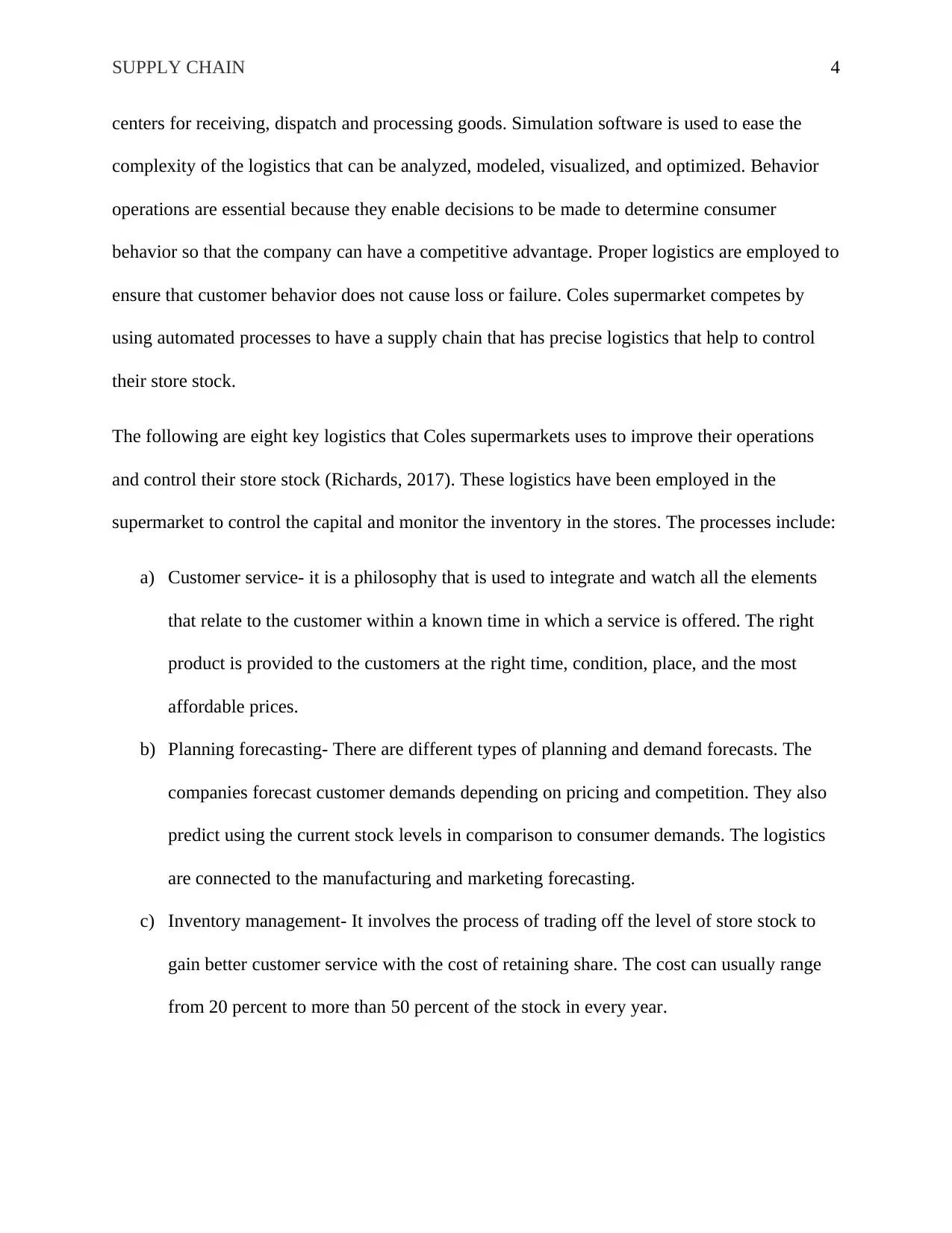
SUPPLY CHAIN 4
centers for receiving, dispatch and processing goods. Simulation software is used to ease the
complexity of the logistics that can be analyzed, modeled, visualized, and optimized. Behavior
operations are essential because they enable decisions to be made to determine consumer
behavior so that the company can have a competitive advantage. Proper logistics are employed to
ensure that customer behavior does not cause loss or failure. Coles supermarket competes by
using automated processes to have a supply chain that has precise logistics that help to control
their store stock.
The following are eight key logistics that Coles supermarkets uses to improve their operations
and control their store stock (Richards, 2017). These logistics have been employed in the
supermarket to control the capital and monitor the inventory in the stores. The processes include:
a) Customer service- it is a philosophy that is used to integrate and watch all the elements
that relate to the customer within a known time in which a service is offered. The right
product is provided to the customers at the right time, condition, place, and the most
affordable prices.
b) Planning forecasting- There are different types of planning and demand forecasts. The
companies forecast customer demands depending on pricing and competition. They also
predict using the current stock levels in comparison to consumer demands. The logistics
are connected to the manufacturing and marketing forecasting.
c) Inventory management- It involves the process of trading off the level of store stock to
gain better customer service with the cost of retaining share. The cost can usually range
from 20 percent to more than 50 percent of the stock in every year.
centers for receiving, dispatch and processing goods. Simulation software is used to ease the
complexity of the logistics that can be analyzed, modeled, visualized, and optimized. Behavior
operations are essential because they enable decisions to be made to determine consumer
behavior so that the company can have a competitive advantage. Proper logistics are employed to
ensure that customer behavior does not cause loss or failure. Coles supermarket competes by
using automated processes to have a supply chain that has precise logistics that help to control
their store stock.
The following are eight key logistics that Coles supermarkets uses to improve their operations
and control their store stock (Richards, 2017). These logistics have been employed in the
supermarket to control the capital and monitor the inventory in the stores. The processes include:
a) Customer service- it is a philosophy that is used to integrate and watch all the elements
that relate to the customer within a known time in which a service is offered. The right
product is provided to the customers at the right time, condition, place, and the most
affordable prices.
b) Planning forecasting- There are different types of planning and demand forecasts. The
companies forecast customer demands depending on pricing and competition. They also
predict using the current stock levels in comparison to consumer demands. The logistics
are connected to the manufacturing and marketing forecasting.
c) Inventory management- It involves the process of trading off the level of store stock to
gain better customer service with the cost of retaining share. The cost can usually range
from 20 percent to more than 50 percent of the stock in every year.
Paraphrase This Document
Need a fresh take? Get an instant paraphrase of this document with our AI Paraphraser
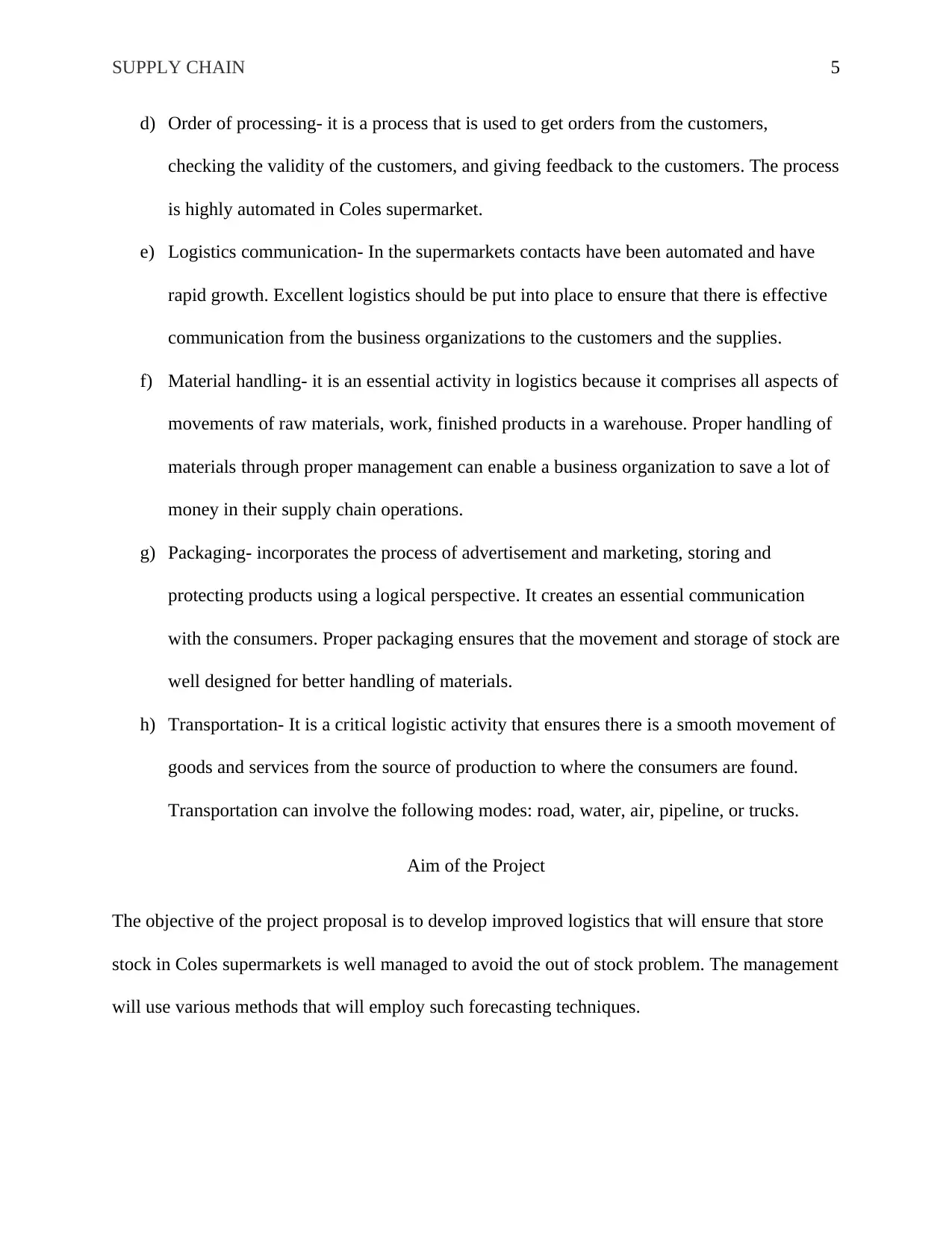
SUPPLY CHAIN 5
d) Order of processing- it is a process that is used to get orders from the customers,
checking the validity of the customers, and giving feedback to the customers. The process
is highly automated in Coles supermarket.
e) Logistics communication- In the supermarkets contacts have been automated and have
rapid growth. Excellent logistics should be put into place to ensure that there is effective
communication from the business organizations to the customers and the supplies.
f) Material handling- it is an essential activity in logistics because it comprises all aspects of
movements of raw materials, work, finished products in a warehouse. Proper handling of
materials through proper management can enable a business organization to save a lot of
money in their supply chain operations.
g) Packaging- incorporates the process of advertisement and marketing, storing and
protecting products using a logical perspective. It creates an essential communication
with the consumers. Proper packaging ensures that the movement and storage of stock are
well designed for better handling of materials.
h) Transportation- It is a critical logistic activity that ensures there is a smooth movement of
goods and services from the source of production to where the consumers are found.
Transportation can involve the following modes: road, water, air, pipeline, or trucks.
Aim of the Project
The objective of the project proposal is to develop improved logistics that will ensure that store
stock in Coles supermarkets is well managed to avoid the out of stock problem. The management
will use various methods that will employ such forecasting techniques.
d) Order of processing- it is a process that is used to get orders from the customers,
checking the validity of the customers, and giving feedback to the customers. The process
is highly automated in Coles supermarket.
e) Logistics communication- In the supermarkets contacts have been automated and have
rapid growth. Excellent logistics should be put into place to ensure that there is effective
communication from the business organizations to the customers and the supplies.
f) Material handling- it is an essential activity in logistics because it comprises all aspects of
movements of raw materials, work, finished products in a warehouse. Proper handling of
materials through proper management can enable a business organization to save a lot of
money in their supply chain operations.
g) Packaging- incorporates the process of advertisement and marketing, storing and
protecting products using a logical perspective. It creates an essential communication
with the consumers. Proper packaging ensures that the movement and storage of stock are
well designed for better handling of materials.
h) Transportation- It is a critical logistic activity that ensures there is a smooth movement of
goods and services from the source of production to where the consumers are found.
Transportation can involve the following modes: road, water, air, pipeline, or trucks.
Aim of the Project
The objective of the project proposal is to develop improved logistics that will ensure that store
stock in Coles supermarkets is well managed to avoid the out of stock problem. The management
will use various methods that will employ such forecasting techniques.
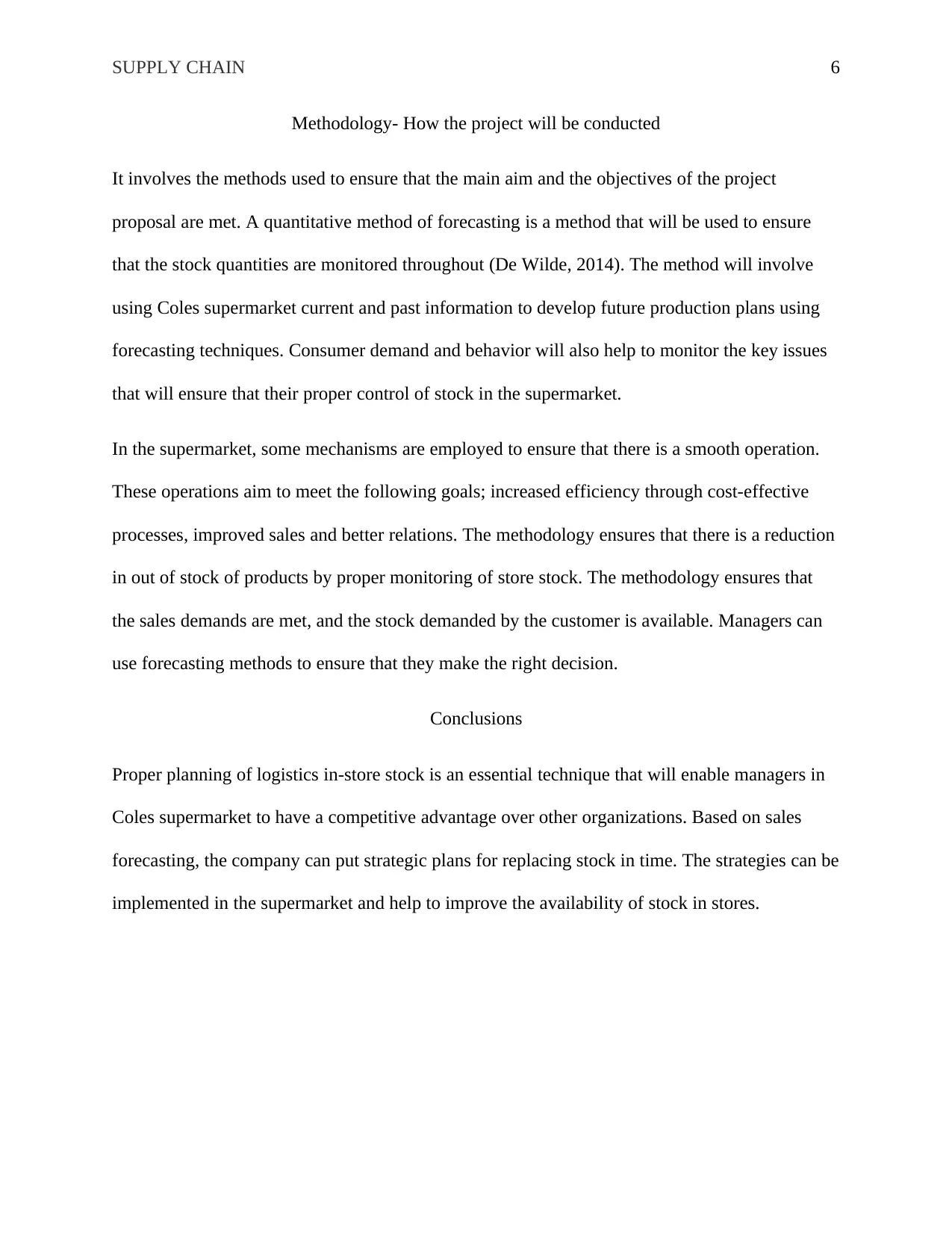
SUPPLY CHAIN 6
Methodology- How the project will be conducted
It involves the methods used to ensure that the main aim and the objectives of the project
proposal are met. A quantitative method of forecasting is a method that will be used to ensure
that the stock quantities are monitored throughout (De Wilde, 2014). The method will involve
using Coles supermarket current and past information to develop future production plans using
forecasting techniques. Consumer demand and behavior will also help to monitor the key issues
that will ensure that their proper control of stock in the supermarket.
In the supermarket, some mechanisms are employed to ensure that there is a smooth operation.
These operations aim to meet the following goals; increased efficiency through cost-effective
processes, improved sales and better relations. The methodology ensures that there is a reduction
in out of stock of products by proper monitoring of store stock. The methodology ensures that
the sales demands are met, and the stock demanded by the customer is available. Managers can
use forecasting methods to ensure that they make the right decision.
Conclusions
Proper planning of logistics in-store stock is an essential technique that will enable managers in
Coles supermarket to have a competitive advantage over other organizations. Based on sales
forecasting, the company can put strategic plans for replacing stock in time. The strategies can be
implemented in the supermarket and help to improve the availability of stock in stores.
Methodology- How the project will be conducted
It involves the methods used to ensure that the main aim and the objectives of the project
proposal are met. A quantitative method of forecasting is a method that will be used to ensure
that the stock quantities are monitored throughout (De Wilde, 2014). The method will involve
using Coles supermarket current and past information to develop future production plans using
forecasting techniques. Consumer demand and behavior will also help to monitor the key issues
that will ensure that their proper control of stock in the supermarket.
In the supermarket, some mechanisms are employed to ensure that there is a smooth operation.
These operations aim to meet the following goals; increased efficiency through cost-effective
processes, improved sales and better relations. The methodology ensures that there is a reduction
in out of stock of products by proper monitoring of store stock. The methodology ensures that
the sales demands are met, and the stock demanded by the customer is available. Managers can
use forecasting methods to ensure that they make the right decision.
Conclusions
Proper planning of logistics in-store stock is an essential technique that will enable managers in
Coles supermarket to have a competitive advantage over other organizations. Based on sales
forecasting, the company can put strategic plans for replacing stock in time. The strategies can be
implemented in the supermarket and help to improve the availability of stock in stores.
⊘ This is a preview!⊘
Do you want full access?
Subscribe today to unlock all pages.

Trusted by 1+ million students worldwide
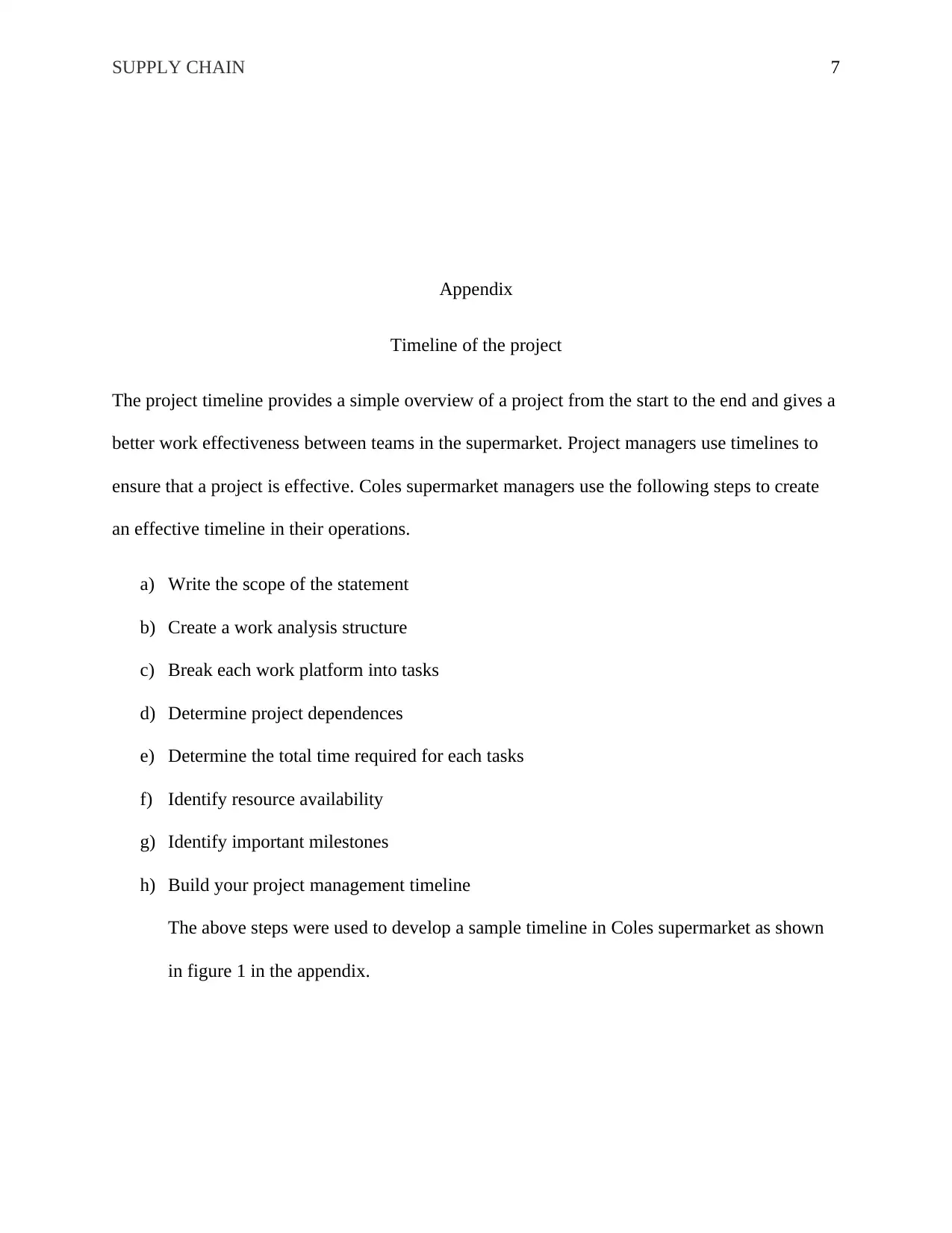
SUPPLY CHAIN 7
Appendix
Timeline of the project
The project timeline provides a simple overview of a project from the start to the end and gives a
better work effectiveness between teams in the supermarket. Project managers use timelines to
ensure that a project is effective. Coles supermarket managers use the following steps to create
an effective timeline in their operations.
a) Write the scope of the statement
b) Create a work analysis structure
c) Break each work platform into tasks
d) Determine project dependences
e) Determine the total time required for each tasks
f) Identify resource availability
g) Identify important milestones
h) Build your project management timeline
The above steps were used to develop a sample timeline in Coles supermarket as shown
in figure 1 in the appendix.
Appendix
Timeline of the project
The project timeline provides a simple overview of a project from the start to the end and gives a
better work effectiveness between teams in the supermarket. Project managers use timelines to
ensure that a project is effective. Coles supermarket managers use the following steps to create
an effective timeline in their operations.
a) Write the scope of the statement
b) Create a work analysis structure
c) Break each work platform into tasks
d) Determine project dependences
e) Determine the total time required for each tasks
f) Identify resource availability
g) Identify important milestones
h) Build your project management timeline
The above steps were used to develop a sample timeline in Coles supermarket as shown
in figure 1 in the appendix.
Paraphrase This Document
Need a fresh take? Get an instant paraphrase of this document with our AI Paraphraser
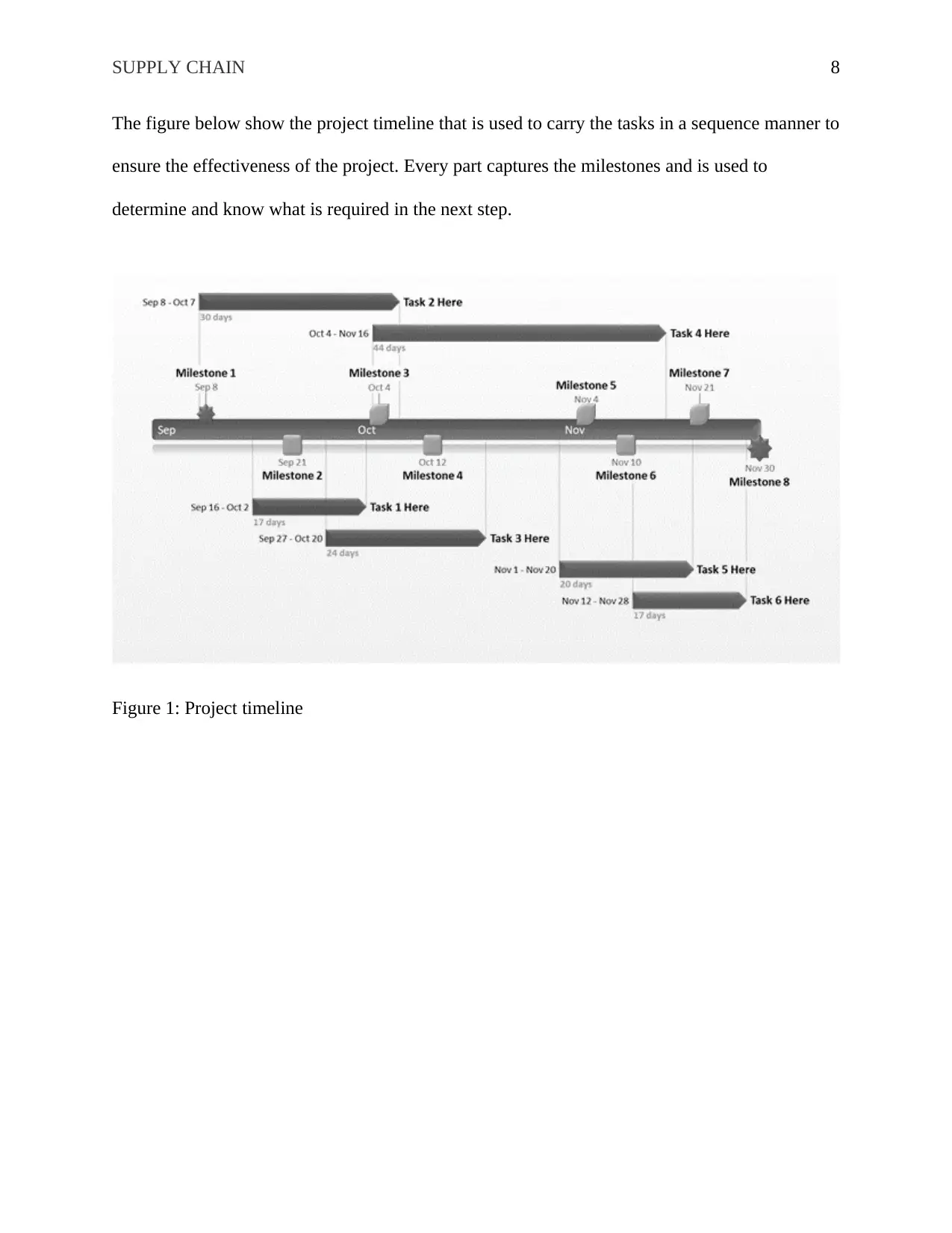
SUPPLY CHAIN 8
The figure below show the project timeline that is used to carry the tasks in a sequence manner to
ensure the effectiveness of the project. Every part captures the milestones and is used to
determine and know what is required in the next step.
Figure 1: Project timeline
The figure below show the project timeline that is used to carry the tasks in a sequence manner to
ensure the effectiveness of the project. Every part captures the milestones and is used to
determine and know what is required in the next step.
Figure 1: Project timeline
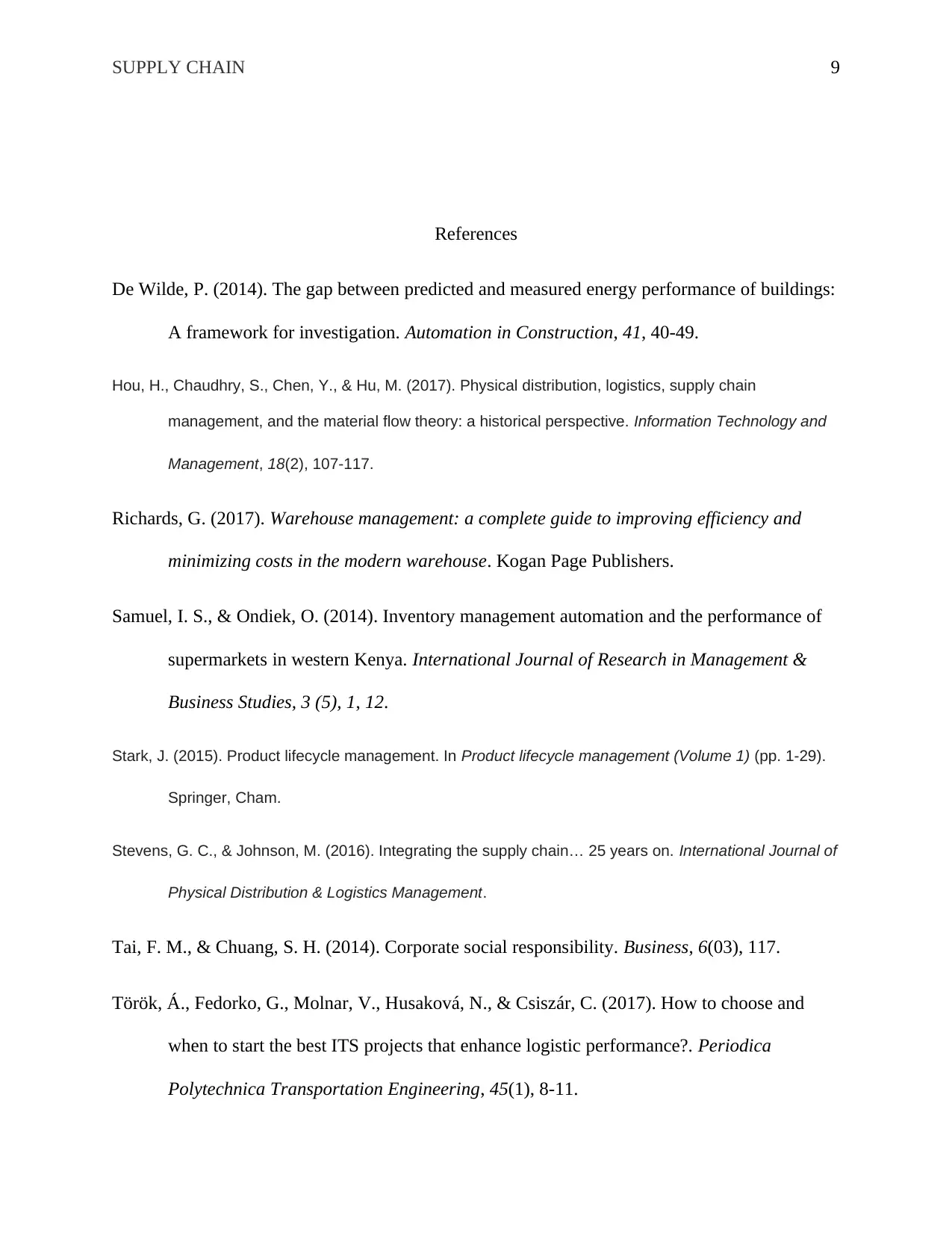
SUPPLY CHAIN 9
References
De Wilde, P. (2014). The gap between predicted and measured energy performance of buildings:
A framework for investigation. Automation in Construction, 41, 40-49.
Hou, H., Chaudhry, S., Chen, Y., & Hu, M. (2017). Physical distribution, logistics, supply chain
management, and the material flow theory: a historical perspective. Information Technology and
Management, 18(2), 107-117.
Richards, G. (2017). Warehouse management: a complete guide to improving efficiency and
minimizing costs in the modern warehouse. Kogan Page Publishers.
Samuel, I. S., & Ondiek, O. (2014). Inventory management automation and the performance of
supermarkets in western Kenya. International Journal of Research in Management &
Business Studies, 3 (5), 1, 12.
Stark, J. (2015). Product lifecycle management. In Product lifecycle management (Volume 1) (pp. 1-29).
Springer, Cham.
Stevens, G. C., & Johnson, M. (2016). Integrating the supply chain… 25 years on. International Journal of
Physical Distribution & Logistics Management.
Tai, F. M., & Chuang, S. H. (2014). Corporate social responsibility. Business, 6(03), 117.
Török, Á., Fedorko, G., Molnar, V., Husaková, N., & Csiszár, C. (2017). How to choose and
when to start the best ITS projects that enhance logistic performance?. Periodica
Polytechnica Transportation Engineering, 45(1), 8-11.
References
De Wilde, P. (2014). The gap between predicted and measured energy performance of buildings:
A framework for investigation. Automation in Construction, 41, 40-49.
Hou, H., Chaudhry, S., Chen, Y., & Hu, M. (2017). Physical distribution, logistics, supply chain
management, and the material flow theory: a historical perspective. Information Technology and
Management, 18(2), 107-117.
Richards, G. (2017). Warehouse management: a complete guide to improving efficiency and
minimizing costs in the modern warehouse. Kogan Page Publishers.
Samuel, I. S., & Ondiek, O. (2014). Inventory management automation and the performance of
supermarkets in western Kenya. International Journal of Research in Management &
Business Studies, 3 (5), 1, 12.
Stark, J. (2015). Product lifecycle management. In Product lifecycle management (Volume 1) (pp. 1-29).
Springer, Cham.
Stevens, G. C., & Johnson, M. (2016). Integrating the supply chain… 25 years on. International Journal of
Physical Distribution & Logistics Management.
Tai, F. M., & Chuang, S. H. (2014). Corporate social responsibility. Business, 6(03), 117.
Török, Á., Fedorko, G., Molnar, V., Husaková, N., & Csiszár, C. (2017). How to choose and
when to start the best ITS projects that enhance logistic performance?. Periodica
Polytechnica Transportation Engineering, 45(1), 8-11.
⊘ This is a preview!⊘
Do you want full access?
Subscribe today to unlock all pages.

Trusted by 1+ million students worldwide

SUPPLY CHAIN 10
1 out of 10
Related Documents
Your All-in-One AI-Powered Toolkit for Academic Success.
+13062052269
info@desklib.com
Available 24*7 on WhatsApp / Email
![[object Object]](/_next/static/media/star-bottom.7253800d.svg)
Unlock your academic potential
Copyright © 2020–2025 A2Z Services. All Rights Reserved. Developed and managed by ZUCOL.





